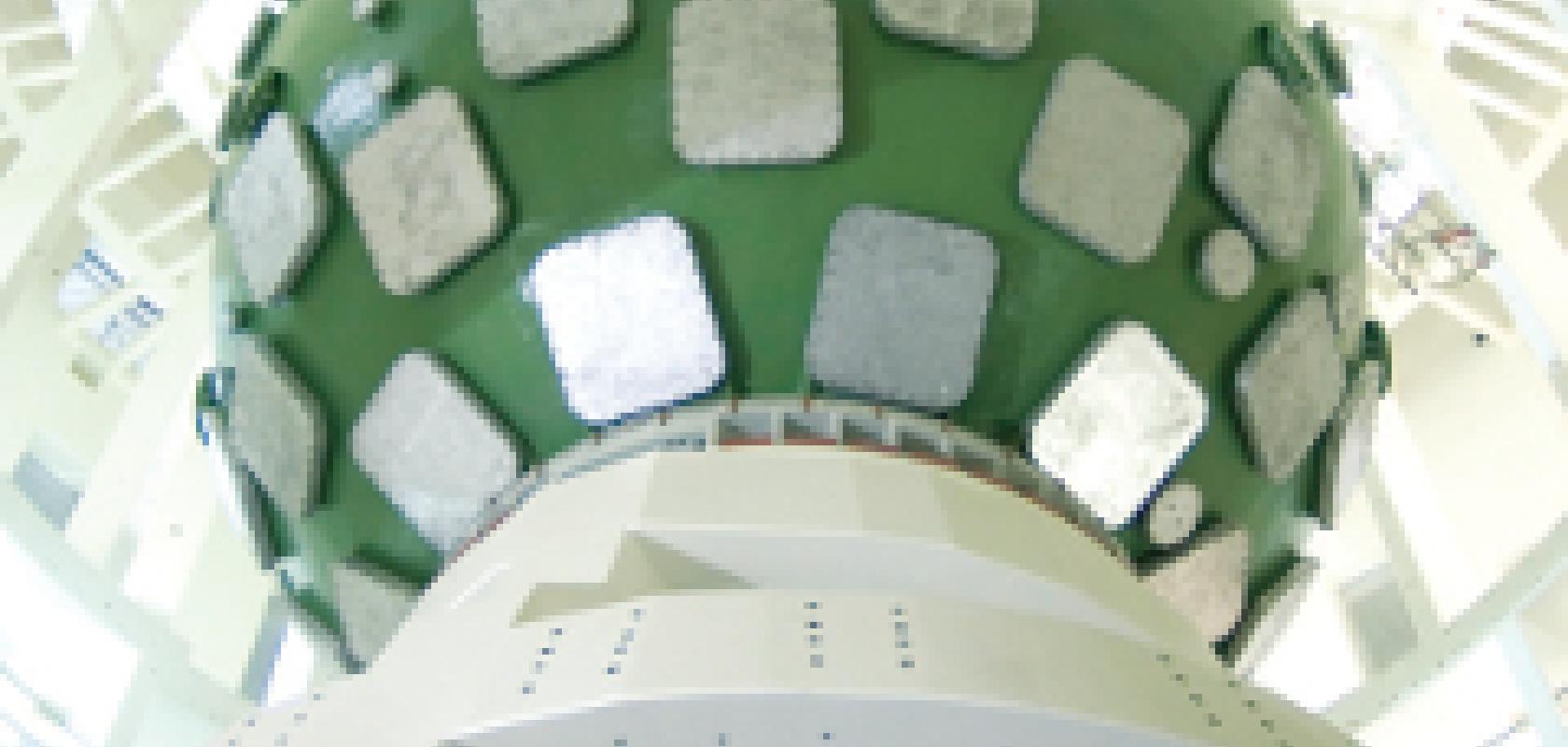The Laser Mėgajoule (LMJ), located at the CEA Cesta site near Bordeaux in the Aquitaine region of France, is a government-funded project aiming to achieve inertial confinement fusion (ICF) using 176 laser beams to deliver up to 1.8MJ of energy. This is one of the latest large-scale investigative projects to break the billion euro barrier, and will no doubt be at the centre of more ‘is science worth the money’ debate when it begins operation in the next few years.
While laser fusion is one of the most exciting clean energy alternatives to fossil fuels, the process seems to have been perpetually 20 to 30 years away from realisation for the past few decades. This has led some people to question whether the ends justify the cost – the LMJ facility was said to have received €3 billion from the French government over 15 years. However, while the main goal of the research is furthering laser fusion for military applications, such as French nuclear deterrence and energy use, the benefits of the project are already being felt in the Aquitaine region.
The LMJ represents a national investment and was 100 per cent funded by France. Hervé Floch, previously project leader for LMJ optics, pointed out that 90 per cent of the €3 billion from the French government has already been reinvested into French industry. ‘A vast amount of investment has been reinjected into French industry; for optics we have many companies that started new production activity in Bordeaux to sit close to the LMJ facility and many of them were elected as primary contractors for different aspects of the laser facility,’ he commented. The remaining 10 per cent had to be spent elsewhere, particularly on optics, because the French industrial production tools were not sized at a sufficient level to release them on schedule.
Floch is now general manager of the Route des Lasers competitive cluster– set up in 2005 and with CEA as one of the main founders – which has strong links with the LMJ facility, not only geographically but in terms of the trickle down of technology and investment. He explained that, as of the end of 2014, Route des Lasers had 131 members, most of which are technology companies. ‘As soon as the LMJ decision was made by President Chirac in 1995, it has practically impacted the Aquitaine region. Before this, there were few companies competent in photonics in the area, mainly concentrated in the Bordeaux area and some laboratories on the university campus. But this was somewhat limited in terms of competence and members from academic or industrial actors.’
According to Floch, 25 start-ups have been created due to the Route des Lasers, with a further six to be officially created this year. However, he added that the technology coming out of the LMJ has produced new ideas, but a lot of the sellable products were created by non-LMJ businesses. He noted that 30 companies have made the decision to move from other regions to the Aquitaine area, commenting: ‘This is because the ecosystem in place is attractive enough to accelerate their economic development and activity.’
Floch continued: ‘The area was chosen to help develop the economic growth of the area. After the LMJ decision in ‘95, about 300 people working on laser science and technology were located in Bordeaux area on the CEA Cesta site with a significant number that moved down to Bordeaux from the Paris area, of which I was one of them. Over the past 13 years, there have been around 1,500 plus highly skilled direct jobs created in the area.
‘The start-ups alone have created around 300 jobs; there have been 450 jobs created in academic positions, and there have been a number of labs created that are furthering the understanding of lasers.’ He added that the most recent of these was the Laboratory for Photonics Numeric and Nanoscience (LP2N) which hosts 50 scientists and is still growing.
But, looking away from photonics and towards the social impacts of the LMJ, Floch noted that, in terms of indirect jobs created by the LMJ, the total is closer to 7,500. In addition, before Route des Lasers was set up there were already 1,500 jobs in photonics and optics taking the total to near 10,000 created due to the photonics industry and the competitive cluster. ‘[Photonics] is a key enabling technology for Europe, as we all know. There is no doubt that the LMJ decision has radically impacted the position of the Aquitaine region in optics and photonics, and has created richness in terms of economic development and jobs and international visibility as well.
‘Everything is connected with these projects,’ Floch continued. ‘They create more activity in the regions, and you have companies that are not directly linked to the project but are still benefitting, which furthers innovation.’ He gave the example of Amplitude Systèmes, which is one of the leaders in ultrashort pulsed laser sources. The company is not directly linked to the LMJ project, but was born in the Aquitaine region and now has 200 employees in France and has recently acquired the company Continuum in the USA.
He explained that the cluster has developed a setup toolbox to reduce waste in innovation and to assist in the transfer from research to a sellable product. One key structure, Alphanov, is a technology transfer centre that aims to accelerate maturity of innovation. Floch explained that this meant improving the Technology Readiness Level (TRL); moving products from level 3, feasibility research, to level 7, demonstrating and prototyping new products, and beyond.
Alphanov’s CEO, Benoit Appert-Collin, elaborated: ‘Alphanov is a technology centre with an important relationship and support from the CEA Cesta, where the Laser Mégajoule is located – our own existence is a direct outcome of the LMJ programme in Aquitaine. We have a significant flow of business with more than 50 employees, 145 customers worldwide and €3.5 million of turnover in 2014.
‘All this business is related to laser development, opto-, electro-, or mechanical-systems and laser micromachining. For example, we offer a very specific expertise in fibre laser components, laser diode drivers in the short pulse range or femtosecond micromachining. We have supported 15 start-ups in the domain and most of this activity is directly or indirectly related to the LMJ.’
Route des Lasers’ Floch added: ‘At the beginning, the LMJ has been very beneficial to the young companies with new needs based in the area. It was initially a catalyst but now the reaction is ongoing, and interactions are happening that are completely separate. Some companies are still benefitting from the facility and it’s an ongoing project, but a lot of others now have very little to do with the project.’
Appert-Collin identified Imagine Optics and ISP as two specific cases of the industrial outcomes made possible by the LMJ, saying ‘both companies are direct contractors to the LMJ and developed a worldwide expertise in their domain to provide a solution at the highest level of performance from the project. Products derived from the LMJ were demonstrated at Photonics West last February.’ He continued: ‘ISP is a great example of how a company essentially involved in mechanics can open to new areas through such huge projects.’ The company worked in collaboration with Imagine Optics to produce two adaptive-optics products for high power or intensive laser applications.
Imagine Optics CEO, Samuel Bucourt, explained how the company was involved with both the LMJ and Route des Lasers. ‘The LMJ developments started in the Paris area, with a first 1/5 prototype and the LIL [Laser Integration Line] project [which was set up in Bordeaux before the LMJ]. We introduced a brand new metrology concept with the “metrologic” Shack-Hartmann in 1997. Previously, the Shack-Hartmann technology was used only for adaptive optics in astronomy applications, with no metrology needs. We promoted this new concept, and I must say that the CEA technical team in charge of the project was really open to that innovation. Later Route des Lasers helped us to found a division of Imagine Optic in Bordeaux, not so far from LMJ facilities and close to the photonics cluster.’
Imagine Optics has provided wavefront sensing and adaptive optics for the LMJ, which Bucourt said is a key technology in the LMJ setup. He continued: ‘There is one wavefront sensor per beamline, which provides the input information to the deformable mirror, through adaptive optics software. This allows the beams to keep the required focus quality and location, on the target. Imagine Optic supplies the sensor itself and has developed the adaptive optics software.’
Wavefront sensing is also intensively used for optical alignment and beam characterisation: ‘For instance, one wavefront sensor is dedicated to align the focalisation module, at the front-end, which consists of four coupled focusing gratings. And, as not all of the beamlines have been built yet, the company’s involvement with the project is ongoing,’ Bucourt said.
He concluded: ‘With the impulse of LMJ and the support of Route des Lasers, we are now the leading company in wavefront sensing and adaptive optics solutions. To be more precise, the Bordeaux cluster has supported us to develop a new generation of deformable mirrors (ILAO) for ultra-intense lasers, which is now the reference in this field. For 18 years – we have been working for LMJ since 1997 – we have been able to explore new application fields for adaptive optics, such as microscopy, ophthalmology (retinal imaging), free-space telecom and much more. We believe that wavefront sensing and adaptive optics market will grow strongly in the coming years.’
Route des Lasers’ Floch summarised: ‘2014 was a complicated economic year in France, but we managed to increase the number of members in the Route des Lasers by 11 per cent. By the end of this year, we hope to reach 150 members. If we were able to demonstrate that, it means in the Aquitaine region and in partnership with other photonics regions, we were able to create, develop and amplify an economic structure based on innovation, and of course, we want to keep moving in this direction. LMJ has been very important; the decision made to locate the facility in the Aquitaine region in 1995 has been essential to that.’
About the author
 Tom Eddershaw is a technical writer for Electro Optics, Imaging & Machine Vision Europe, and Laser Systems Europe.
Tom Eddershaw is a technical writer for Electro Optics, Imaging & Machine Vision Europe, and Laser Systems Europe.
You can contact him on tom.eddershaw@europascience.com or on +44 (0) 1223 275 478.
Find us on Twitter at @ElectroOptics, @IMVEurope, @LaserSystemsMag and @ESTomEddershaw.


